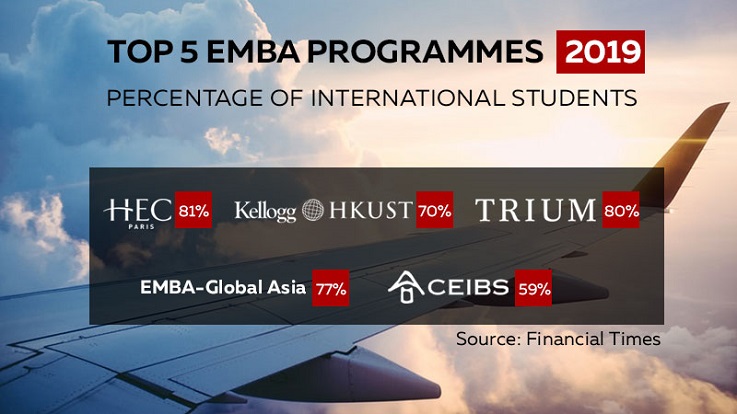The Executive MBA format prepares you to take on a senior level management position.

The prestigious business publication the Financial Times publishes an annual Executive MBA ranking which presents the top 100 EMBA programmes for senior working managers. This is the 19th edition of the ranking.
The Executive MBA is a part-time study format designed for experienced professionals from all over the world who are looking to step into a higher leadership role.
“Executive MBA programmes typically place an emphasis on leadership and strategy, thus preparing students to take on senior level general management positions or perhaps to run their own businesses,” explain representatives from Premier EMBA – the series of events that gather Executive MBA programmes ranked in the worldwide top 50 by the Financial Times.
Browse Executive MBA showcase events in cities around the world
Top scorers
In 2019, the French HEC Paris jumped five places to reach the number one spot, largely thanks to the strengthened career progress and work experience of the surveyed graduates. This is considered to be an important move forward, as the school entered the ranking only last year.
Programmes offered jointly by several different schools round off the top three, with the Kellogg/HKUST Executive MBA (China) ranking second and the TRIUM Global Executive MBA (France/UK/US/China) ranking third. Overall, joint EMBA studies are well-represented throughout the list of programmes. Some executives headed to business school prefer to opt for a joint programme due to the global travel opportunities and study trips on offer.
Read: Rising EMBA Applications Point to a Bright Future for the Degree
International features
Globally minded professionals are able to browse several features that measure the international outlook of business schools in the ranking. For instance, the “international course experience” rank takes into account the classroom teaching carried out outside the country where the business school is located. In 2019, the TRIUM Global Executive MBA retains its number one position for international course experience. “The 18-month course is spread over five locations – modules are taken in Shanghai, Paris, London, New York and California – but the format is designed so that students spend 10 weeks away from the office,” the FT reports.
Prospective applicants can also consult the “international students”, “international faculty”, and “international board” features of the table to find the programmes that offer the best diversity.

Schools in Asia
Although the performance of some Asian schools has dropped in this year’s ranking, the continent is still well-represented both by solo and joint EMBA programmes. The Chinese CEIBS successfully retained its fifth place from 2018. “The school’s alumni have strong career progression, ranked seventh in the category overall, with many alumni in senior roles such as directors or vice-presidents,” Jonathan Moules, editor for the Financial Times, explains. “It was also number three for average salary, at USD 446,495.”
Apart from China, other Asian representatives in the FT Executive MBA Ranking include schools from Singapore, South Korea, and Taiwan.
Gender diversity
While EMBA programmes show stability in the rankings year on year, one aspect that could stand improvement is the gender diversity among students and faculty. The joint programme run by Washington University’s Olin Business School (US) and Fudan (China) is the only member of the top 10 to achieve respectable in-class gender diversity, with women accounting for 49% of the cohort. According to the Financial Times, this might be a reflection of the gender balance among senior business levels of some organisations.
Although its overall positioning dropped 15 places from 2018, GIBS Business School at the University of Pretoria (South Africa) is the most gender-balanced school in the ranking: women make up 50% of faculty and 51% of the student body.
Read: 3 Reasons to Get an Executive MBA
How is the ranking created?
Participation in the ranking is voluntary and at the business schools’ request. To be eligible, the school must be accredited by either AACSB or EQUIS. The EMBA programme must be cohort-based, with students enrolling and graduating together, with at least 30 graduates each year.
The data is collected using two online surveys. The first one is completed by participating schools. Information provided by the business schools informs 10 criteria that collectively account for 35% of the final ranking.
The second survey is completed by alumni who graduated from their programme in 2015. The Financial Times requires a response rate of 20% (or 20 fully completed responses, whichever is the greater) from the alumni survey for a school to be considered for the final ranking.
Alumni responses inform five ranking criteria: salary today, salary increase, career progress, work experience, and aims achieved. They account together for 55% of the ranking’s weight.
Note: The latest description of the ranking methodology was provided by the Financial Times in 2018.




